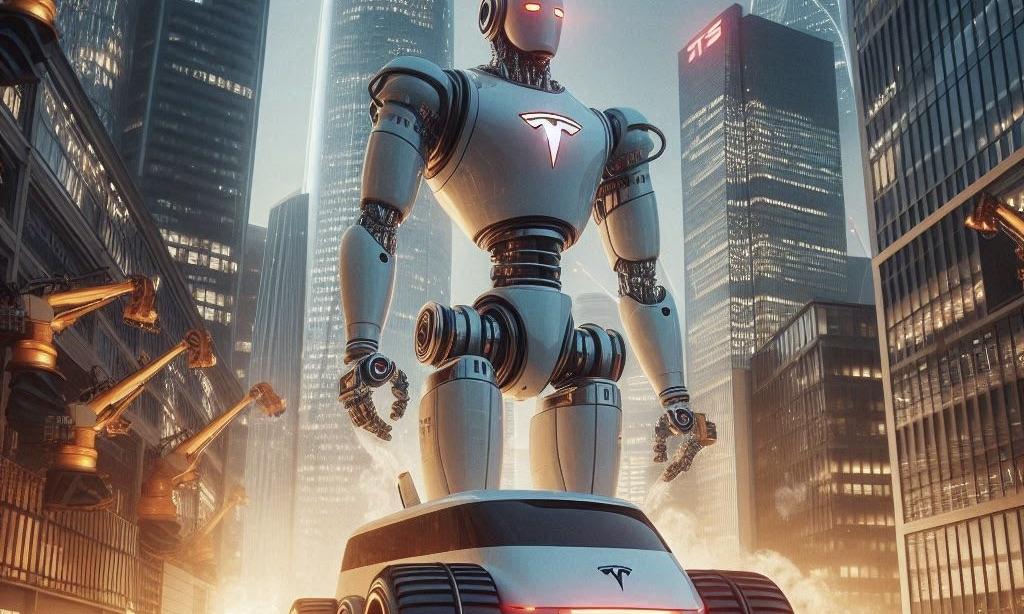Deutsche Bank forecasts Tesla’s humanoid robot, Optimus, could generate $10 billion in annual revenue by 2035, despite some critics labeling the report as overly optimistic. The report highlights the vast market potential of Tesla’s evolving AI-driven robotics business, with substantial growth expected in the coming years.
Deutsche Bank’s Bold Tesla Forecast Highlights $141 Billion Automotive Revenue by 2030 Amid Criticism
Deutsche Bank released a new coverage initiation report for Tesla on September 10. Some industry professionals have called it "one of the most naive nonsense research reports" to have graced the buy-side research sphere. However, the report effectively contextualizes the vast market opportunity that the EV behemoth can seize if it executes its strategy effectively, even though it employs exaggerated multiples to value Tesla's diverse revenue streams.
It is essential to mention that Cathie Wood's ARK Invest has also published a new blog on September 10 that elaborates on the global revenue opportunity for humanoid robotics before discussing Deutsche Bank's latest report on Tesla. ARK's primary case anticipates a productivity increase of 50 percent to 200 percent due to robotics. Although some of ARK's projections are exceedingly optimistic, the blog post serves as an adequate introduction to the disruptive capabilities of this emerging technology.
Deutsche Bank anticipates that Tesla's automotive division will generate annual revenues of approximately $141 billion by 2030, as indicated by a delivery estimate of roughly 4 million units and an average selling price (ASP) of $35,000. Nevertheless, the analyst subsequently employs Apple's multiples to determine the segment's value, which is not truly an apple-to-apple comparison, mainly because the margins of the iPhone manufacturer are orders of magnitude greater than those of Tesla.
Deutsche Bank Projects $15 Billion in Robotaxi Revenue and $10 Billion from Optimus Robots by 2035
In the realm of robotaxis, the banking giant anticipates that Tesla will operate a fleet of approximately one million vehicles by 2035, generating annual revenues approaching $15 billion.
Based on battery deployment estimates of 155 GWh, Deutsche Bank anticipates that Tesla's energy storage business will generate $41 billion in annual sales by 2030.
Lastly, the banking behemoth anticipates that Tesla's bespoke humanoid robot Optimus will generate $10 billion in annual revenue by 2035, with a sales volume of 200,000 units and an average selling price (ASP) of $50,000. Deutsche Bank has faced criticism for using NVIDIA's multiples to assess Tesla's Optimus and robotaxi revenue streams.
However, the report does provide a critical perspective. The Optimus robot can generate annual savings of $31,900 despite its exorbitant price of $100,000, provided it can completely supplant a human worker.
Undoubtedly, the most recent incarnation of Tesla's Optimus robot will be displayed at the organization's subsequent AI Day event. Elon Musk disclosed in July that Tesla will utilize Optimus internally in limited quantities in 2025. By 2026, the electric vehicle manufacturer plans to increase the production of the humanoid robot and officially incorporate it into its product line.
Optimus can interact with the external environment using a neural network-trained, AI-equipped brain. The bipedal robot can perform menial, labor-intensive tasks, and substantial AI capabilities are in the pipeline. Tesla's humanoid robot can also navigate, map obstacles, and monitor objects using its custom neural network. Despite its bulk, the bipedal robot Optimus can pick up an egg with precision, thanks to its sensitive tactile finger sensors.



 Anthropic Launches HIPAA-Compliant Healthcare Tools for Claude AI Amid Growing Competition
Anthropic Launches HIPAA-Compliant Healthcare Tools for Claude AI Amid Growing Competition  Trump Weighs Blocking Exxon Investment as Venezuela Deemed “Uninvestable”
Trump Weighs Blocking Exxon Investment as Venezuela Deemed “Uninvestable”  xAI Cash Burn Highlights the High Cost of Competing in Generative AI
xAI Cash Burn Highlights the High Cost of Competing in Generative AI  Hyundai Motor Shares Surge on Nvidia Partnership Speculation
Hyundai Motor Shares Surge on Nvidia Partnership Speculation  China’s AI Sector Pushes to Close U.S. Tech Gap Amid Chipmaking Challenges
China’s AI Sector Pushes to Close U.S. Tech Gap Amid Chipmaking Challenges  GM Takes $6 Billion EV Write-Down as Electric Vehicle Demand Slows in the U.S.
GM Takes $6 Billion EV Write-Down as Electric Vehicle Demand Slows in the U.S.  Nvidia Unveils Rubin Platform to Power Next Wave of AI Infrastructure
Nvidia Unveils Rubin Platform to Power Next Wave of AI Infrastructure  HSBC Expands UAE Presence With New Asset Management Business and Onshore Funds
HSBC Expands UAE Presence With New Asset Management Business and Onshore Funds  EU Orders Elon Musk’s X to Preserve Grok AI Data Amid Probe Into Illegal Content
EU Orders Elon Musk’s X to Preserve Grok AI Data Amid Probe Into Illegal Content  BTIG Initiates Buy on SoftBank as AI and Robotics Strategy Gains Momentum
BTIG Initiates Buy on SoftBank as AI and Robotics Strategy Gains Momentum  Lenovo Unveils AI Cloud Gigafactory With NVIDIA and Launches New AI Platform at CES 2026
Lenovo Unveils AI Cloud Gigafactory With NVIDIA and Launches New AI Platform at CES 2026  Discord Confidentially Files for U.S. IPO, Signaling Major Milestone
Discord Confidentially Files for U.S. IPO, Signaling Major Milestone  SMIC Shares Climb as China Boosts Chipmaking Support Amid AI Optimism
SMIC Shares Climb as China Boosts Chipmaking Support Amid AI Optimism  Vitol to Ship First U.S. Naphtha Cargo to Venezuela Under New Oil Supply Deal
Vitol to Ship First U.S. Naphtha Cargo to Venezuela Under New Oil Supply Deal  Samsung Forecasts Strong Q4 Profit on AI-Driven Memory Chip Boom
Samsung Forecasts Strong Q4 Profit on AI-Driven Memory Chip Boom  FDA Limits Regulation of Wearable Devices and Wellness Software, Boosting Health Tech Industry
FDA Limits Regulation of Wearable Devices and Wellness Software, Boosting Health Tech Industry  Johnson & Johnson Secures Tariff Exemption by Agreeing to Lower Drug Prices in the U.S.
Johnson & Johnson Secures Tariff Exemption by Agreeing to Lower Drug Prices in the U.S. 































